The Pillar coinage
Introduction
On 9 June 1728, King Philip V of Spain issued a royal decree to bring about sweeping changes in the manufacture of coins in the New World colonies. All hammered macuquina or 'cob' coinage would be replaced by coins made using round planchets punched from a rolled, flat sheet of silver of even thickness ('milled'), struck by a screw press, with carefully prepared dies placed in medal alignment, and endowed with a decorated edge that would be impossible to shave or clip without notice. The Mexico City mint, being the first and best-prepared mint of the Americas, was the first to receive the relevant minting equipment and thus move toward compliance.
Further changes were made by the Ordinances given in Cazalla on 16 July 1730. As part of the new changes, the Royal Treasury now had control of the jobs within the Mint, which were no longer in the hands of private individuals. For centuries, these had been leased or sold to the private sector. In Mexico, on 25 February 1733, according to the previous Ordinances, the positions that had been for sale were incorporated into the Crown, although it would not be until 1778 when all the workers of the Mint were employees of the Crown. Part of the new changes was in 1731 when the Viceroy Marquis of Casafuerte ordered Nicolás Peinado (who was an architect by profession) to begin the expansion of the Mint, which would be completed in 1734 and inaugurated by the Viceroy Antonio de Vizarrón. These works provided space for the new equipment for an investment of $454,000.
Jorge ProctorJorge Proctor, "A Madrid columnario of 1729 preserved in the Museum of the Mexican Mint" in gives the following timeline:
9 June 1728: Pragmatics state that copper samples of the new coin must be made.
8 September 1728: The design is approved.
26 October 1728: Diego de la Casa, the Chief Carver of the Segovia Mint, was commissioned to design a new coin to replace the currency minted until then in the mints of the Kingdoms of the Indies, in accordance with the provisions of the Pragmatics of 9 June 1728.
19 August 1729: The final design was made by the Salamanca carver Francisco Fernández Escudero, which he sent to the Marquis of Feria, who confirmed that he had received the request for the samples
22 August 1729: Diego de Sosa, royal carver, was finishing the designs of the pieces of eight, two, and half reales, leaving the four reales for the following week, and asked whether the samples should be sent in copper or silver.
24 August 1729: First sample coins were made in silver for the monarch, and later in copper to send to the mints of the Indies.
6 October 1729: Two samples of all the pieces of the monetary system, from the half to the eight reales, were delivered, without assayer's marks or value One of these sets was given to Nicolás Peinado Valenzuela, the new director of the Mexican Mint. who went to his new destination together with his lieutenant Alonso García Cortés and the engraver Francisco Monllor.

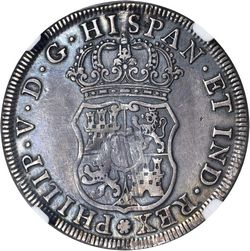
KM-94 4r 1732 MO (Stack’s Bowers ANA Auction, 4 August 2017, lot 21157)
Thes coinsonly four pieces for the 4 reales denomination are known lacks the assayer's initials and denomination and may be considered "trial pieces struck directly from the matrix sent from Madrid, to serve as examples of how the coin layout should look” Brad Yonaka, A Variety Guide to the Fractional Pillar Coinage of Mexico City 1732-1771,.
The new coins were instigated on 29 March 1732, in the presence of the viceroy of New Spain ,the Marquis of Casafuerte, the superintendent of the Mint Joseph Fernández Veytia Linage, the director Nicolás Peinado y Valenzuela, the lieutenant Alonso García Cortés and the engraver Francisco Monllor. The viceroy threw the coins from the balcony of the National Palace to his subjects to celebrate.
However, circulation would not begin until the mint had enough currency as a backstop, which would happen until 23 December 1732, in an announcement by the town crier of Mexico City. In November 1732 the amount of 200,000 pesos of silver was deposited with the Real Audiencia to be used to produce the new coinage. On 17 December[text needed] and 20 December 1732[text needed] bandos (proclamations) were distributed across the country informing the populace of the new coinage and that they were to be accepted just as the previous cob coinagecorrespondence included with lot 41138.
The first truly milled and machine-struck round coins were produced in 1732, running in parallel with an intermediate method that used polygonal planchets trimmed to correct weights (klippes). By 1735 the mint was producing only the coin type originally mandated by the king in 1728. The fractional silver denominations were half, one, two, and four reales, with the crown-sized eight reales being the standard trade dollar value in silver weight. Coin purity was set as 11 dineros (916.666 fine silver).
The coin type was named pillar or 'columnario' for the two pillars on either side of the globes on the date side. These pillars had been a feature of Spanish colonial coinage for the better part of two centuries, but the new uncrowded design type and even planchet surfaces gave them a prominence and austerity that had been lacking in earlier coinage.
The period of pillar design at the Mexico City mint ended in 1771, with the introduction of the portrait type reales in 1772 as decreed by King Charles III. Concurrently, silver fineness was reduced to 903.0 fine silver, giving pillar coinage a slightly higher intrinsic value than the later portrait type.
Unlike the eight reales coins, which were the primary rneans by which the Spanish king received his 'royal fifth' from the silver mines of the New World, the fractional denominations were struck, for the most part, for local circulation. Relatively few of them appear in caches from sunken treasure fleets (though a good number of four reales appear in some wrecks). Some made their way north into the North American colonies and to Asia, where they were accepted in trade.
Mo and Mx mint marks
Because of confusion over the interpretation of the law coins produced in 1733 can be found with both a Mx and a Mo mintmark.
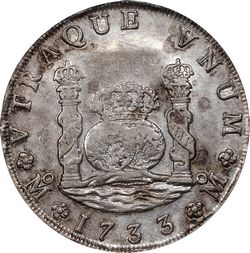
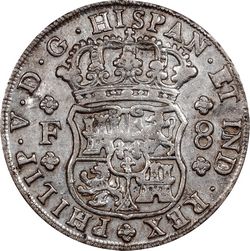
KM 103 8r 1733 Mo F (Stack’s Bowers NYINC auction, 13 January 2023, lot 21149)
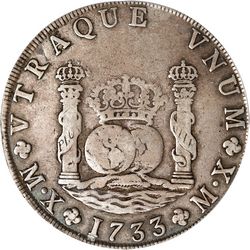
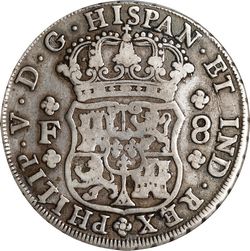
KM 103 8r 1733 MX F (Stack’s Bowers NYINC auction, 13 January 2023, lot 21150)
Klippe coinage (cortadas)
In 1732 there was not enough capacity of the presses to meet the demand for coinage, so the cobs (macuquinas) continued to be minted by hammer while the new Pillar coins were produced on the presses. In 1733 the production of cobs was transferred to presses, but with the circular stamps on irregular blanks, this time square or rectangular and cut with scissors These so-called "klippes" continued to be produced until the first quarter of 1734 but only in values of 4 and 8 reales.
The only assayers of these coins were Manuel de León (M) and Francisco Antonio de la Peña y Flores (F). There are perfectly round klippes,which can be confused with royals.
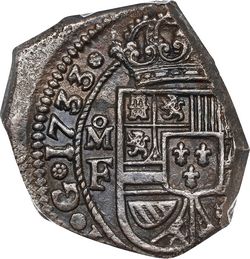
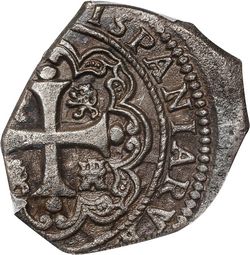
KM-unl 4r klippe 1733 Mo F (Stack’s Bowers NYINC Auction, 13 January 2024, lot 53122)
A fairly rare type featuring just a single assayer, F.
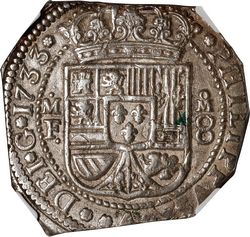
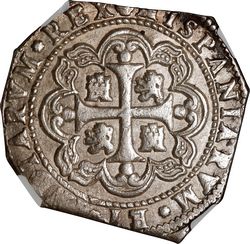
KM 48 8r klippe 1733 Mo MF (Stack’s Bowers NYINC Auction, 13 January 2023, lot 21148)
Although little is published about how "Klippes" were produced, a lot can be learned through examination of the coins. For instance, all "Klippes" were struck with aligned dies set at a fixed axis, including the Cobs struck with Klippe dies.
The vast majority of coins examined have a medallic die axis, a small portion of them have coin die axis and a minute number have a slightly rotated medallic die axis. This information tells us that all Klippes, including the ones struck on Cob planchets were in fact machine struck. The planchets for the 1733 transitional coins or Cobs struck with Klippe dies, were produced in the same manner as traditional cobs. Klippe planchets however were produced differently, first by rolling or flattening silver into a sheet by the process of a mule-powered roller press. Planchets were then cut from the sheet and weighed. If needed, adjustment cuts or clips were made until the planchet was of the correct weight standard. The coin pictured below is an example of how planchets were cut from sheets.
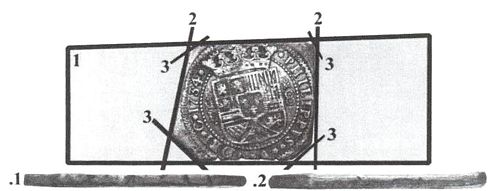
Note the coin has two opposing edges at the top and bottom showing signs of stress cracks or edge splits. These represent the original edges from the sheet of silver from which the planchet was cut. This coin also contains two opposing cut edges at left and right, showing evidence of sheer marks. These marks are where the initial cuts were made creating the planchet. Adjustment cuts were then made in the comers until the planchet was of the correct weight standard,
On 24 October 1734, a document was issued[text needed] in which Spain thanked Mexico for ceasing to manufacture the macuquina coinage.
Thus, the pressure of time, the lack of trained personnel and the lack of machinery in time, as well as the constant demand for currency, meant that in the beginning there were a variety of different coins produced. Kent Ponterio has detailed all the different 8 reales of 1832 to 1834.
Philip V
The total amount of coins minted during Philip's reign (which included cob, klippe and pillar coinage) is given here. The pillar coinage consisted of half real, one real, two reales, four reales, eight reales.
Ferdinand VI
The total amount of coins minted during Ferdinand's reign is given here. The Pillar coinage consisted of half real, one real, two reales, four reales, eight reales.
On 1 April 1747 the Mexican Mint received instructions to change the legend on coins to Ferdinand VI, and the matrices were sent by 23 June. So 1747 produced coins with the legends of both Philip V and Ferdinand VI.
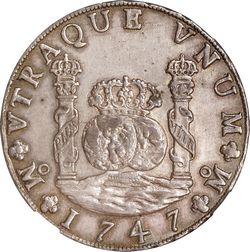
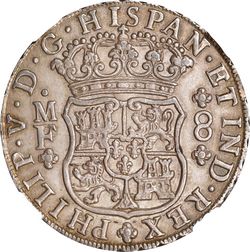
KM 103 8r 1747 Mo MF Philip V (Stack’s Bowers ANA Auction, 16 May 2023 2017, lot 70025)
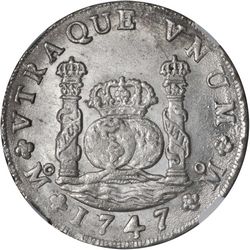
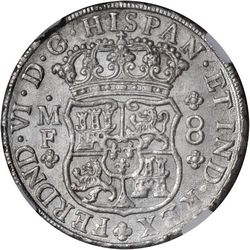
KM 104.1 8r 1747 Mo MF Ferdinand VI (Stack’s Bowers ANA Auction, 4 August 2017, lot 21170)
In 1754 there was a slight change in the design as the crowns atop the Pillars changed, with the left one changing from “Royal” to “Imperial”, since Ferdinand VI held both titles of King and Emperor.
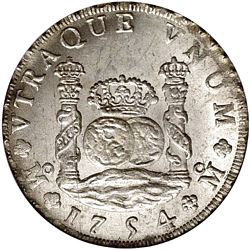
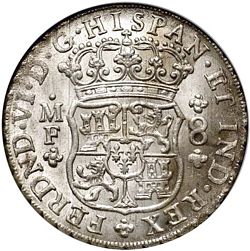
KM 104.1 8r 1754 Mo MF (Stack’s Bowers Auction, 20 March 2007, lot 108)

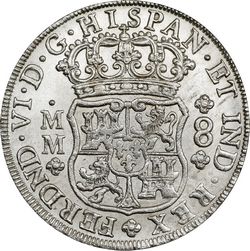
KM 104.2 8r 1754 Mo MM/MF (Stack’s Bowers Auction, 22 April 2023, lot 44035)
 Detail of the “Imperial” and “Royal” crown of an 8 reales
Detail of the “Imperial” and “Royal” crown of an 8 reales
This adaptation was first only carried out on 8 Reales pieces, in the 4 Reales it happened in the following year and not until 1757 in the other denominations.
Charles III
The total amount of coins minted during Charles's reign (which included the Pillar and later Bust coinage) is given here. The Pillar coinage consisted of half real, one real, two reales, four reales, eight reales.
It is interesting to mention that during his reign a decree was issued on 19 September 1759[text needed] to authorize the minting and manufacture of the new Bust coinage, but for some reason they did not begin to be minted until 8 April 1772.
